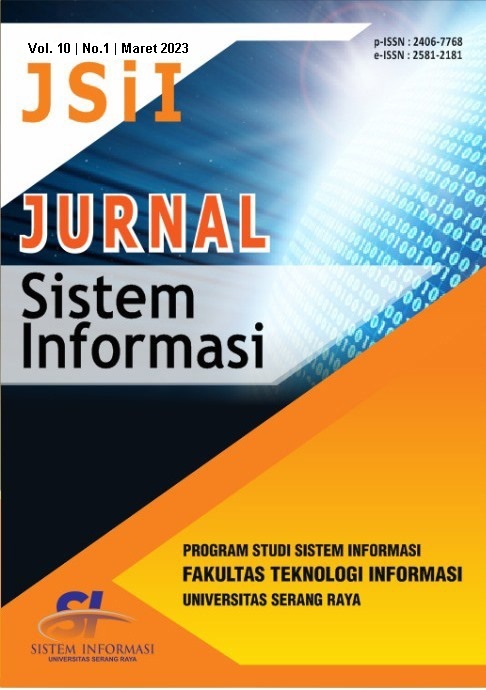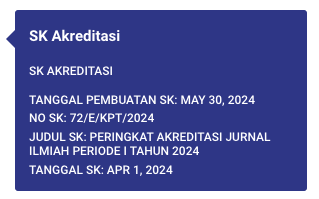EVALUASI PENERAPAN SINGLE SIGN-ON SAML DAN OAUTH 2.0: STUDI PADA PERGURUAN TINGGI YOGYAKARTA
DOI:
https://doi.org/10.30656/jsii.v10i1.6186Abstract
Dalam memutuskan strategi Single Sign-On (SSO) yang efektif, perguruan tinggi perlu memahami manfaat SSO, mengidentifikasi kebutuhan spesifik organisasi, dan memilih protokol yang akan memenuhi kebutuhan tersebut. Kontribusi penelitian ini adalah menganalisis efektifitas penerapan SSO protokol SAML dan OAuth 2.0 pada perguruan tinggi Yogyakarta. Langkah penelitian meliputi pengumpulan data, kemudian melakukan analisis penerapan protokol SAML dan OAuth 2.0 terhadap referensi yang relevan. Pengumpulan data dilakukan melalui literatur review, observasi pada domain-domain website resmi perguruan tinggi, survei, dan wawancara kepada 22 responden dari 17 Pusat IT perguruan tinggi. Dari hasil survei dan wawancara ditemukan ketidaksesuaian penerapan protokol pada 7 perguruan tinggi yang mengintegrasikan aplikasi native (desktop-based/mobile-based) dan IoT menggunakan SAML dan juga ditemukan ketidaksesuaian penerapan protokol yaitu OAuth 2.0 pada 2 perguruan tinggi. Hasil analisis menunjukkan bahwa beberapa perguruan tinggi belum menerapkan SSO secara efektif. Meskipun 60% perguruan tinggi mengklaim telah melakukan riset dalam pemilihan protokol SSO yang digunakan, namun pada praktiknya masih dijumpai penerapan SSO yang justru menambah kompleksitas permasalahan sebelumnya.
Kata kunci: evaluasi, oauth 2.0, perguruan tinggi, saml, single sign-on
References
K. Costello and M. Rimol, “Gartner Forecasts Worldwide Public Cloud End-User Spending to Grow 23% in 2021,†https://www.gartner.com/en/newsroom/press-releases/2021-04-21-gartner-forecasts-worldwide-public-cloud-end-user-spending-to-grow-23-percent-in-2021, Apr. 21, 2021.
Z. Triartono and R. M. Negara, “Implementation of Role-Based Access Control on OAuth 2.0 as Authentication and Authorization System,†2019 6th International Conference on Electrical Engineering, Computer Science and Informatics (EECSI), 2019, doi: https://doi.org/10.23919/EECSI48112.2019.8977061.
M. Aldosary and N. Alqahtani, “A Survey on Federated Identity Management Systems Limitation and Solutions,†International Journal of Network Security & Its Applications, vol. 13, no. 03, pp. 43–59, May 2021, doi: 10.5121/ijnsa.2021.13304.
I. Indu, P. M. R. Anand, and V. Bhaskar, “Identity and access management in cloud environment: Mechanisms and challenges,†Engineering Science and Technology, an International Journal, vol. 21, no. 4, pp. 574–588, 2018, doi: 10.1016/j.jestch.2018.05.010.
J. Basney, P. Cao, and T. Fleury, “Investigating Root Causes of Authentication Failures Using a SAML and OIDC Observatory,†in Proceedings - 2020 IEEE 6th International Conference on Dependability in Sensor, Cloud and Big Data Systems and Application, DependSys 2020, Dec. 2020, pp. 119–126. doi: 10.1109/DependSys51298.2020.00026.
N. Naik and P. Jenkins, “An Analysis of Open Standard Identity Protocols in Cloud Computing Security Paradigmâ€, doi: 10.1109/DASC-PICom-DataCom-CyberSciTec.2016.85.
C. Glahn and R. Mazza, “Integrating Native Mobile Apps into Institutional Educational-technology Ecosystems,†17th World Conference on Mobile and Contextual Learning, pp. 77–83, 2018.
E. Ito, Y. Kasahara, and N. Fujimura, “Implementation and operation of the kyushu university authentication system,†in Proceedings ACM SIGUCCS User Services Conference, 2013, pp. 137–142. doi: 10.1145/2504776.2504788.
J. Basney et al., “CILogon: Enabling Federated Identity and Access Management for Scientific Collaborations,†2019. [Online]. Available: https://www.shibboleth.net/
V. Kalfa, G. Roussos, D. Charidimou, and A. Agorogianni, “Coping with the COVID-19 challenges in a comprehensive university: learning tools and procedures adopted by Aristotle University of Thessaloniki,†Proceedings of the European University Information Systems Conference 2021, 2021, doi: https://doi.org/10.29007/hhvq.
M. Iordan, G. Bîzoi, A.-C. Bîzoi, and C. Herman, “MOODLE PLATFORM’ SUPPORT IN DIGITIZING THE ACADEMIC PROCESS. CASE STUDY WEST UNIVERSITY OF TIMIȘOARA,†2021, [Online]. Available: https://www.researchgate.net/publication/361440775
V. Kumar and D. Sharma, “Creating Collaborative and Convenient Learning Environment Using Cloud-Based Moodle LMS: An Instructor and Administrator Perspective,†International Journal of Web-Based Learning and Teaching Technologies, vol. 11, no. 1, pp. 35–50, Jan. 2016, doi: 10.4018/IJWLTT.2016010103.
A. Juma, J. RodrÃguez, J. Caraguay, M. Naranjo, A. Quiña-Mera, and I. GarcÃa-Santillán, “Integration and evaluation of social networks in virtual learning environments: A case study,†in Communications in Computer and Information Science, 2019, vol. 895, pp. 245–258. doi: 10.1007/978-3-030-05532-5_18.
A. A. Mawgoud, M. H. N. Taha, and N. E. M. Khalifa, “Security Threats of Social Internet of Things in the Higher Education Environment,†in Studies in Computational Intelligence, vol. 846, Springer Verlag, 2020, pp. 151–171. doi: 10.1007/978-3-030-24513-9_9.
A. Arina, “Analysis of IoT security issues used in Higher Education Institutions,†International Journal of Mathematics and Computer Research, vol. 09, no. 05, May 2021, doi: 10.47191/ijmcr/v9i5.01.
J. vom Brocke, A. Simons, B. Niehaves, B. Niehaves, and K. Reimer, “Reconstructing the Giant- On the Importance of Rigour in Documenting the Literature Search Process,†European Conference on Information Systems, p. 2009, 2009, [Online]. Available: https://aisel.aisnet.org/ecis2009/161
N. Naik and P. Jenkins, “Securing digital identities in the cloud by selecting an apposite Federated Identity Management from SAML, OAuth and OpenID Connect,†2017 11th International Conference on Research Challenges in Information Science (RCIS), 2017, doi: 10.1109/RCIS.2017.7956534.
J. Carretero, G. Izquierdo-Moreno, M. Vasile-Cabezas, and J. Garcia-Blas, “Federated identity architecture of the European eID System,†IEEE Access, vol. 6, pp. 75302–75326, 2018, doi: 10.1109/ACCESS.2018.2882870.
T. Ueda and Y. Ikeda, “Socio-economics and educational case study with cost-effective IOT campus by the use of wearable, tablet, cloud and open E-learning services,†Japan Society for the Promotion of Science KAKENHI, 2017.
S. Hammann, R. Sasse, and D. Basin, “Privacy-Preserving OpenID Connect,†ASIA CCS ’20: Proceedings of the 15th ACM Asia Conference on Computer and Communications Security, 2020, doi: https://doi.org/10.1145/3320269.3384724.
C. A. Christiansen and L. Stuart, “Identity as a Service on the Journey to the Cloud IDC OPINION,†2016.
U. Joshi, S. Cha, and S. Esmaili-Sardari, “Towards adoption of authentication and authorization in identity management and single sign on,†Advances in Science, Technology and Engineering Systems, vol. 3, no. 5, pp. 492–500, 2018, doi: 10.25046/aj030556.
OASIS, “Security Assertion Markup Language (SAML) V2.0 Technical Overview,†2008. [Online]. Available: http://docs. oasis-open.org/security/saml/Post2.0/sstc-saml-tech-overview-2.0.html
Downloads
Published
Issue
Section
License
- This work is licensed under a Creative Commons Attribution-ShareAlike 4.0 International License.
-
Author(s)' Warranties
The author warrants that the article is original, written by stated author(s), has not been published before, contains no unlawful statements, does not infringe the rights of others, is subject to copyright that is vested exclusively in the author and free of any third party rights, and that any necessary written permissions to quote from other sources have been obtained by the author(s).
- Information
- Notice about change in the copyright policy of the journal 'Jurnal Sistem Informasi (JSiI)' : "From Vol 1, onwards the copyright of the article published in the journal 'Jurnal Sistem Informasi' will be retained by the author"













.jpg)














